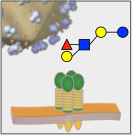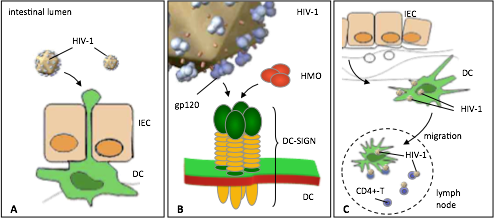
HIV-1 Mother-to-Child Transmission
Breast-feeding is the predominant postnatal transmission route for HIV-1 infection in children. However, a majority of breast-fed infants do not become HIV-infected despite continuous exposure to the virus through their mothers’ milk over many months. What protects some breast-fed infants from HIV-1 infection? HIV-1 entry across the infant’s mucosal barrier is partially mediated through binding of the HIV-1 surface glycoprotein gp120 to DC-SIGN (Dendritic Cell-Specific ICAM3-Grabbing Non-Integrin) on human dendritic cells. Lewis antigen glycans, present in human milk, bind to DC-SIGN and inhibit HIV-1 transfer to CD4+ T lymphocytes. Human Milk Oligosaccharides (HMO) carry one or more Lewis antigen epitopes. We hypothesize that HMO compete with gp120 for DC-SIGN binding.
In collaboration with Dr. Benhur Lee’s lab at the University of California - Los Angeles, we have shown in two independent assays that physiological concentrations of HMO significantly reduce gp120-binding to DC-SIGN by more than 80% (Hong et al. 2009). These results may provide an additional explanation for the inhibitory effects of human milk on HIV-1 mother-to-child-transmission.
Our lab now aims to identify the specific individual HMO that interact with DC-SIGN. The results may guide the development of glycan-based drugs that prevent transmission of HIV-1 and other pathogens that use DC-SIGN as an entry point. However, blocking DC-SIGN may be a two edged sword.
In collaboration with Dr. Grace Aldrovandi’s lab at the Children’s Hospital Los Angeles and Dr. Louise Kuhn’s lab at Columbia University we also aim to identify whether the presence of specific oligosaccharides in human milk correlates with a reduced risk for HIV-1 mother-to-child-transmission (Bode et al. 2012).




